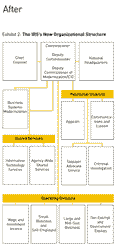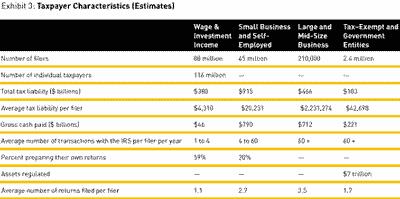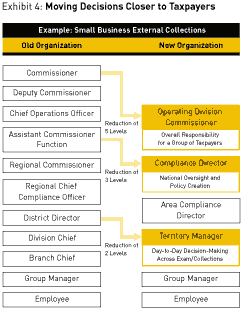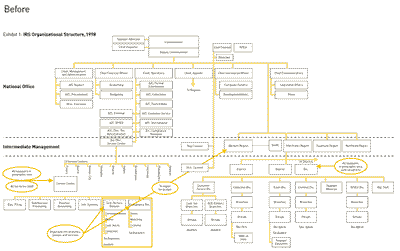Customer-izing the IRS
From a 1950s-style geographic-function matrix to a 21st-century customer-centered enterprise: the anatomy of a strategy-based transformation.
(originally published by Booz & Company)If the Internal Revenue Service were a company, it would be among the largest in the world. The IRS collected $2 trillion in taxes last year. This year we should receive more than 230 million tax returns — individual, partnership, corporate, fiduciary, estate, employment, excise, and others — touching virtually every American. Since the agency accomplishes this huge task with fewer than 118,000 employees — about one-third the size of the workforce of the General Motors Corporation — you might also conclude that the IRS has ranked among the best-managed and most efficient organizations on earth.
Unfortunately, it has not. Far from it: Through the 1980s and ’90s, America’s tax agency was the subject of a growing chorus of criticism, from a presidential commission, several congressional committees, and the vice president’s National Partnership for Reinventing Government — as well as the public. Tax forms were difficult to follow, and answers to questions about them were hard to come by; some taxpayers felt their rights too often were ignored, or trampled, by agency field personnel; tax collection and compliance in many areas were spotty, or worse.
Having come to the IRS as commissioner in 1997, after a 27-year career in international business and information technology consulting, I could see the criticism was not only justified, but unsurprising. The last time the agency had been reorganized was 1950, an era of one-income families, locally based businesses, and a population about one-third the size of today’s. It was as if IBM were operating in a PC-based universe with management systems unchanged since the days of Univac. No wonder, then, that the Congress overwhelmingly passed the IRS Restructuring and Reform Act in July 1998, requiring us to redefine our mission and reorganize our structure to serve taxpayers better.
The landmark legislation was long overdue. Any company failing to keep up with the changing needs and expectations of its customers for so many years would long ago have disappeared. Because the taxes the IRS collects support everything from national defense to Social Security, we literally could not afford to let that happen. So with the Restructuring and Reform Act as our guide, we took on the task of transforming America’s tax agency into a customer-centered enterprise. It was a transformation challenge similar to those faced by other organizations in the contemporary economy — only bigger.
Redefining the Mission
Historically, the IRS had a simple mission: to collect the proper amount of taxes due from individual taxpayers and businesses. The Reform Act directed us to restate our mission to place an emphasis on serving the public and meeting taxpayers’ needs. That meant fulfilling the legitimate public expectation that the IRS would do its job in a manner no less effective than that of high-quality private- and public-sector organizations. (After all, every taxpayer is also a customer of many other businesses and institutions, many of which consistently provide high-quality service while also providing excellent results for shareholders and other stakeholders.) The agency’s redefinition also meant building absolute respect for taxpayer rights into our business practices, while ensuring that taxes due are paid. And it meant measuring our success or failure not just in terms of the taxes we collect, but also in terms of the effect on the people — a fundamentally new direction and a new challenge.
After a period of intense consultation with the public, key public- and private-sector organizations, and IRS employees, we translated this direction into a new mission statement: Provide America’s taxpayers top-quality service by helping them understand and meet their tax responsibilities and by applying the tax law with integrity and fairness to all. In support of this new customer service–focused mission, we outlined three new goals:
- Service to each taxpayer
- Service to all taxpayers
- Productivity through a quality work environment
Defining the mission and undergirding it with specific goals was as important to the IRS’s transformation as it would be to any company moving in a new strategic direction, for it helped create the road map the agency would need to follow. Service to each taxpayer means making filing easier, providing first-quality service to taxpayers who need help with returns or accounts, and giving prompt, professional, helpful treatment to taxpayers. Service to all taxpayers means adopting business practices that make compliance easier and ensuring that tax laws are applied fairly — that we all pay our share as required by law. Productivity will come through providing employees with high-quality technology tools, adequate training, and effective management, and through engaging them in the goals of the organization.
Success will be defined as achieving all our goals. We cannot succeed if we collect taxes but do not provide good service and respect taxpayer rights. The reverse is equally true. Customer satisfaction is not achieved by failing to collect taxes that are properly due. And we cannot succeed if we cannot use our limited resources productively, or if we fail to provide employees with the tools and training needed to do their job well.
After defining our strategic goals, we identified five “levers,” or drivers of change, to guide creation of the new IRS. These are:
- Customer-focused operating divisions
- Management roles with clear responsibility
- Revamped business practices
- New technology
- Balanced measures of performance
Just as we must meet all three of our strategic goals to succeed, we knew we had to implement all five levers of change. We could not achieve our goals with our existing organizational structure and lines of accountability. We could not succeed without changing our business practices in ways that captured the benefits of today’s technology. Nor could we ensure the success of the new IRS without changing how we measure our progress.
From Strategy to Structure
Creating an organizational structure that could successfully achieve the new goals required prying apart and understanding a configuration that had been in place since the presidency of Harry Truman. Although arcane, it was not unusual: The traditional IRS structure represented the way many businesses were organized for decades — around internal technical disciplines or functions and geographic locations. In our case, the functions included Exam, Collection, and Taxpayer Services. The geographic offices included Districts and Regions. Think back to when there were the “Big Eight” accounting firms: They were mostly organized the same way (audit, tax, and consulting), each under a local office head.
When we started creating our new organization, the IRS had 43 heads of office reporting through regional or intermediate offices, and an operations unit in headquarters that had nine assistant commissioners. This all came together only at the very top, at the Commissioner/ Deputy Commissioner level. (See Exhibit 1.)
The geographic configuration had its advantages. If you were a taxpayer in California, you could call an IRS office in California — the service was local. But the setup had its problems as well. Managers and employees were required to manage a very broad scope of services, which often led to poor service. Since our people had to be versed in the entire tax code, their expertise in specific areas of tax law was not always high. The geography-based structure also allowed each local office to handle issues differently: A taxpayer in California could conceivably get different answers to a question than a taxpayer in Maine. The IRS developed national programs to overcome these differences, but that negated the benefits of having local offices.
Being organized around disciplines also had its advantages. Our Submission Processing, Exam, Collection, and Taxpayer Services disciplines developed highly efficient ways of doing their work. But taxpayers frequently had problems finding out who was responsible for their accounts. If you thought you’d paid your taxes but the IRS said you hadn’t, solving the impasse too often meant a runaround. Submission Processing assured you the problem was in Exam; Exam said your return had already been turned over to Collection; and Taxpayer Services couldn’t access the other functions’ computer systems to find the answer. Everyone was responsible for part of the job, but no one was responsible for the whole job.
The requirement that the functions be all things to all taxpayers additionally meant that the functions, like the geographies, were not always able to tailor their services to meet the needs of specific kinds of taxpayers. Those needs differ markedly. Wage earners have requirements different from those of small-business owners and the self-employed, and large corporations have needs different from those of tax-exempt organizations. Without clear accountability for these and other major customer groups, our functional units and geographic units were unable to help them solve problems before they occurred, through education and other programs that we call pre-filing.
In the last two decades, most large businesses, especially those that are knowledge-based, such as professional services firms, have moved away from such functional or geographic structures and toward a customer-focused one. Technology was the great enabler. Reorganizing and managing a large organization by customer-service lines simply wasn’t possible 40 years ago. Without computer networks, faxes, e-mail, and low-cost long-distance phone service, the only way to manage effectively was to be physically close to customers. Technology shrank distances and made it possible to create new forms of organization.
Of equal importance, technology also accustomed Americans to levels and types of service that previously had been unthinkable. This prompted expectations that the Internal Revenue Service would offer the same services — expectations that we had no choice but to try to meet.
Designing the New IRS
Working with consultants from Booz-Allen & Hamilton, we adopted a four-phase approach to designing and implementing a new organizational structure for the agency. In Phase I, which lasted from March 1998 to August 1998, a small group of IRS experts worked with the consultants to assess the modernization concept, define the new organization architecture, and outline the transformation program. In Phase IIA, which ran from September 1998 to April 1999, we moved to engage a broader set of IRS leaders. We built our team around people who had long been influential in the agency — those who had developed reputations as reformers and who had wanted to make broad changes, but had never had the opportunity to affect the service agency-wide. At first just 14 people participated, but we later put out a broader search for IRS people at all levels.
From the start, we wanted to involve executives, managers, and employees in the reorganization process, understanding that, if they were allowed to “own the result,” they would work to drive it down into the very core of our dispersed organization. To foster this engagement, we took steps that would have been dramatic even for many private-sector companies. For example, throughout the process, we very heavily involved the National Treasury Employees Union, which represents IRS employees, by placing both bargaining-unit and non-bargaining-unit employees on every team. That effort paid off in both substantive contributions and a sense of spirit that “civilians” probably wouldn’t expect in a government agency. Both union leaders and agency management were overwhelmed by the number of those wanting to participate. We also made an early decision to offer every employee of the old IRS a job in the new IRS, within the employee’s current commuting area. Ensuring job security enabled employees to feel more comfortable “stepping out of the box.” Although the fit between the skills needed in the new IRS and the distribution of skills from the old IRS is not always perfect, we are using a variety of personnel incentives to achieve the proper balance.
We also devoted major time and effort to communicating the project’s purpose, goals, and process details to employees who were not directly involved in the planning effort. Without employee communication, no organization transformation program can succeed; indeed, secrecy and failure to communicate across organizational boundaries are recipes for almost certain failure. Our efforts included:
- A two-page newsletter sent out every other week to employees. This is produced both electronically and in print, because our entire workforce is not yet “wired”
- National meetings and interactive satellite television broadcasts for top managers at key times
- A weekly voice-mail broadcast and periodic voice-mail updates from top management and union officials to employees. Managers distribute the text of these broadcast messages to those who do not have voice mail
- A guide and periodic updates for IRS managers to use in talking with their employees about modernization
- A weekly publication distributed to managers by e-mail to help them keep their employees informed of breaking news
- A video, and publicity and training materials to support the launch of the new IRS
Ultimately, Phase IIA directly involved about 200 people at all levels of the organization, grouped in teams with the consultants. Small groups of team members spent weeks on the road meeting with stakeholders and IRS employees to get their ideas about how the IRS should be organized to provide the best service. The teams incorporated this input into detailed hypotheses about how each part of the new IRS should be structured. Then they solicited more input to test their initial designs and incorporated these revisions into “final” plans for the new organization. The results of all this teamwork were detailed organization designs that defined the modernized IRS.
In Phase IIB, from May 1999 to December 31, 1999, we involved even more employees, to put more detail into the plans and to determine how to go about implementing them. The number of IRS team members increased to about 500, and the action moved increasingly to the field, with town meetings and a regular flow of e-mail and other communication. In this phase, we detailed our designs for process and systems changes, developed a comprehensive implementation plan, and built “ownership” for the change throughout the agency.
Finally, we conducted Phase III, the implementation, which took from January 1, 2000 to October 1, 2000. Different parts of the new IRS arrived at Phase III at different times. For each division, Phase III started when the blueprint and implementation plan for the division was approved, the top managers for the division were selected, and the financial and administrative systems were aligned to support it. During Phase III, each division completed its staffing and began implementing the business practices needed to accomplish its mission. The last divisions entered Phase III on October 1, 2000.
Moving the organization from the old structure to the new one has been a delicate and complicated process. Keep in mind that throughout the transformation, for the most part, the old structure and the new were occupying the same facilities and were populated by the same employees, who will be using the same information systems until new ones are designed and installed. The old IRS had to keep collecting the taxes, assisting taxpayers, and doing all its other functions all through the creation of the new organization, and the new organization had to continue performing these functions without interruption. My favorite analogy is that modernization is similar to completely rebuilding an airplane while flying it.
The New IRS Organization
The modernized structure that resulted from this transformation effort is modeled after the structure employed by many companies serving diverse customer segments in today’s fast-moving economy. We went from a 1950s-style functional geographic matrix organization to customer-facing business units, with a set of shared services and a small corporate core. (See Exhibit 2.) Specifically, the new IRS includes:
- Four operating divisions — Wage and Investment Income (W&I), Small Business and Self-Employed (SB/SE), Large and Mid-Size Business (LMSB), and Tax-Exempt and Government Entities (TE/GE)
- Two service organizations — Information Systems and Agency-Wide Shared Services
- Separate specialized independent channels for taxpayers — Appeals and the Taxpayer Advocate Service
- Criminal Investigation, which is a line unit with sole responsibility for investigation of criminal violations of the tax law
- Communications and Liaison (C&L), which provides IRS employees and external stakeholders a communications capability that promotes understanding of the service’s corporate mission and goals and helps taxpayers understand and meet their tax responsibilities
- Chief Counsel, which provides tax advice, guidance, and legislative services to all components of the IRS
- A smaller National Headquarters office, which assumes the overall role of setting broad policy, reviewing plans and goals of the operating units, and developing major improvement initiatives
 |
| Click picture to enlarge |
The consultations helped identify the salient characteristics of the different taxpayer groups. (See Exhibit 3.) For example, when businesses have about $5 million in revenue, their needs are pretty clearly different from smaller organizations. So we assigned these mid-size businesses to the same division as large corporations, rather than grouping them with smaller businesses as in the past. Similar consultations helped us determine proper customer-facing units to serve individual taxpayers. Having to deal with various tax schedules complicates the financial affairs of self-employed taxpayers, making their needs quite different from those of taxpayers who have only wage or investment income. Input from tax practitioners and others persuaded us to place self-employed taxpayers and small businesses in the same operating division, where we can provide the services they need to meet their tax obligations.

Such input also influenced our grouping of organizations that do not pay taxes. The IRS long ago created a functional division to handle tax-exempt organizations, but not one to handle government entities, which do not pay income tax but do withhold taxes for millions of employees. Guidance from government entities led us to include them in the new Tax-Exempt and Government Entities division.
To complement the new structure, we abandoned the “jack of all trades, master of none” ethic among management. Our new structure sets forth clear end-to-end responsibility and authority for a top official, supported by a small senior management team, to serve a set of taxpayers. Equally important, since the taxpayers served are reasonably homogeneous in their needs, managers at all levels are able — and expected — to be knowledgeable in the substantive problems and issues that arise in administering the tax law in their division. By dedicating a separate unit with full responsibility for serving each set of taxpayers, we can develop the best internal structure and business practices to achieve our strategic goals based on the specific taxpayer needs and problems.
For example, let’s look at the Large and Mid-Size Business division. This division serves only about 210,000 filers; by comparison, the Wage and Investment Income division serves more than 116 million taxpayers. Although LMSB’s taxpayer base is small, it generates close to half a trillion dollars in taxes.
Mid-size and large businesses generally have in-house tax organizations, so they rarely need assistance at IRS walk-in sites or over the toll-free phone lines. They have complex tax problems involving tax law interpretation, accounting principles, and regulatory issues. LMSB is set up to create an atmosphere of teamwork between the IRS and the taxpayers to solve such complex tax issues. By focusing on the issues that affect large and mid-size businesses, the LMSB staff can be experts on the tax issues their clients face. LMSB is dedicated to solving problems before the businesses file their returns through issue resolution and other methods.
To ensure its employees can place maximum expertise at the service of LMSB taxpayers, the division is organized around industry segments. Each LMSB taxpayer is served by one of five umbrella organizations, whose headquarters are where those industries are concentrated. The five industry segments are financial services and health care (headquartered in Manhattan); retailers, food, and pharmaceuticals (Chicago); natural resources (Houston); communication, technology, and media (San Francisco area); and heavy manufacturing, construction, and transportation (New Jersey). LMSB also has more than 7,000 industry segment specialists working in other locations throughout the country to serve businesses not located in the headquarters areas.
This contrasts with the geographic organization of the Wage and Investment Income division, which has hundreds of local offices that report through geographic territory and area offices to the Wage and Investment Income headquarters in Atlanta. The industry-based organization of LMSB allows it to work nationally and internationally on issues affecting entire industries, whereas the geography-based organization in W&I allows it to work closely with individual taxpayers.
New Leadership Teams
The top personnel in LMSB, as in the other operating divisions, are a mix of career IRS managers and experienced managers from the private sector. The IRS managers provide detailed knowledge of how the tax system works, while the managers coming in from the private sector help the IRS view tax administration from the taxpayers’ perspective. LMSB’s commissioner, Larry Langdon, was vice president, tax licensing and customs, for Hewlett-Packard Company. His deputy, Deborah Nolan, was one of the top managers in the IRS International function.
We are also teaming career IRS managers with experts from the private sector in each industry segment. LMSB’s senior industry advisors for the financial services and health care industry segment and the retailers, food, and pharmaceuticals industry segment both came to the IRS from major accounting firms. The senior industry advisor for natural resources worked for a major international energy company. LMSB is selecting senior advisors for the other two industry segments.
LMSB already has several initiatives in place as part of its issue management strategy to serve large and mid-size businesses better. Its Pre-filing Agreement Program allows taxpayers to request examination of specific issues relating to a tax return before it is filed. This helps resolve problems involving factual questions and well-settled principles of law. Pre-filing examinations can resolve problems more effectively and efficiently than post-filing examinations because the taxpayer and the IRS have more timely access to the records and personnel relevant to the issue. A pre-filing examination also provides the taxpayer with a greater level of certainty regarding the examined issue at an earlier point.
Industry Issue Resolution (IIR) is another LMSB initiative. The IIR process is designed to resolve issues that are common to many large business taxpayers. The goal of the IIR program is to move away from auditing frequently disputed industry issues on a case-by-case basis and toward solutions that apply to significant numbers of business taxpayers. The program is aimed at establishing a consistent IRS position on industry issues. The benefits include reducing costs and burden for taxpayers and the IRS and eliminating uncertainty involving tax treatment.
A third LMSB initiative is the Comprehensive Case Resolution Program, which we will be testing with a few businesses. Large businesses that currently have at least one open year under examination in LMSB and at least one prior year in Appeals can apply to participate in this test. Taxpayers will save time and resources by working with one team from the IRS rather than several different functional areas.
Like LMSB and W&I, the other two operating divisions are structured to meet the needs of the taxpayers they serve. The Small Business and Self-Employed division, dealing more frequently with taxpayers on more complex issues, has a compliance organization, including both examination and collection groups, reporting to a multi-functional manager. Through pre-filing activities, like education, SB/SE will help taxpayers get it right the first time, so they can avoid compliance problems down the road. And the Tax-Exempt and Government Entities division is creating support structures, akin to LMSB’s industry segments, for each type of taxpayer it will serve — exempt organizations, pension plans, and government entities — with common supporting elements.
To aid these customer-facing units, other divisions have also been reorganized. The Chief Counsel has established a senior legal executive as the Division Counsel for each operating division to participate fully in the plans and activities of the operating division management and to provide high-quality legal advice and representation. The Appeals organization remains an independent channel for taxpayers who have a dispute over a recommended enforcement action. The Taxpayer Advocate Service is geographically distributed to provide local contact with taxpayers, and includes a taxpayer advocate in each operating division to identify systemic problems in the division.
Leaner and Cleaner
The new IRS is much flatter than the old organization. In general, there are only four levels of management, half the old number, between the top official and the front-line employee, facilitating effective two-way communication. (See Exhibit 4.) Through this simplified structure, we can attack the problem of slow responses to taxpayer queries and needs. We can provide faster resolutions, make faster decisions, and improve our ability to deploy new technology.
 We have also built into the new organization the basic quality principle that it’s faster, more efficient, and better for everyone to prevent a problem than to solve it. In making cars, for example, it’s very expensive to issue a recall. It’s cheaper to fix a defect before the car leaves the factory. But it’s best to improve the design and manufacturing process so no defect occurs in the first place. That’s why we’ve built into all of the business divisions the principle of working with taxpayers before they file their returns. Should we have to intervene through the collection or exam process, we want to identify and act on these problems as quickly as possible.
We have also built into the new organization the basic quality principle that it’s faster, more efficient, and better for everyone to prevent a problem than to solve it. In making cars, for example, it’s very expensive to issue a recall. It’s cheaper to fix a defect before the car leaves the factory. But it’s best to improve the design and manufacturing process so no defect occurs in the first place. That’s why we’ve built into all of the business divisions the principle of working with taxpayers before they file their returns. Should we have to intervene through the collection or exam process, we want to identify and act on these problems as quickly as possible.
Speed isn’t the only value the new organization honors — consistency also counts, and for a great deal. The organizational design aims to promote nationwide consistency in the way we do business with taxpayers, and the way we do business internally. By centralizing management information systems resources under the Chief Information Officer, and other common services under a shared services organization, we are focusing on providing efficient and standardized common services where appropriate.
Efficiency has been championed, as well. The entire reorganization of the IRS and its improved ability to serve customers has been accomplished with the same level of staff. The number of personnel doing back-end compliance was kept stable, but we dramatically increased the number of people on the front end — those who come in contact with customers — by taking people out of administration. When we started, there were about 300 people in education. Today, there are 3,000 working in pre-filing activities.
Since the final phase of the IRS’s reorganization began fully only last October, it is too early for truly meaningful metrics. But the trend lines are all going in the right direction. After an eight-year decline, customer satisfaction has risen every month since the new structure was adopted. Employee satisfaction, which we measure very carefully, has already improved from about 53 percent to about 60 percent. As the new organization really takes hold and new processes are implemented, we believe these metrics are going to move in a powerful way.
Here’s an apparent paradox. You will hear that in spite of this massive reorganization, nothing has changed. The phone numbers have not changed, and the revenue agent handling your case will be the same. IRS office locations have not changed. So, what has?
Here’s the answer. The new organizational structure is not the real change that will occur at the IRS. It merely enables us to change. It enables us to put into place the leadership teams and the tens of thousands of IRS employees they will lead. It enables us to give them the authority, tools, and responsibility to make a difference. It enables us to proceed with the long process of improving our business and information systems so they will meet the needs of our customers. Thus far, we’ve improved service only a little, but we intend to improve it a lot as our employees, working with consultants and our customers, develop new systems, deploy new technology, and implement improved ways of measuring our progress over the next several years.
Over time, it is the employees of the IRS — not the structure — that will produce the visible, tangible changes in service, compliance, and productivity that taxpayers across the nation so much deserve and will finally see. ![]()
Reprint No. 01210





